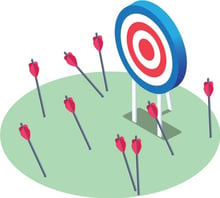 The product roadmap is an essential piece of communication for your teams. It is a high-level document that conveys the strategic goals of a product amongst the product line and portfolio. With this in mind, a product roadmap should outline the development process, highlight key metrics, and display important details, such as dependencies, milestone targets, and features of the product.
The product roadmap is an essential piece of communication for your teams. It is a high-level document that conveys the strategic goals of a product amongst the product line and portfolio. With this in mind, a product roadmap should outline the development process, highlight key metrics, and display important details, such as dependencies, milestone targets, and features of the product.
Create A Goal Oriented Roadmap That Focuses on The Outcomes
 Each roadmap should define what you are hoping to achieve with the corresponding product. It is important to relay the value of the product to your company executives and product teams, so they understand why they are building it. Clear goals help align everyone on your team to work toward the same goals.
Each roadmap should define what you are hoping to achieve with the corresponding product. It is important to relay the value of the product to your company executives and product teams, so they understand why they are building it. Clear goals help align everyone on your team to work toward the same goals.
Once you have defined the product vision, it becomes easier to select the features that you need to achieve it. We caution you to resist the urge to build a product roadmap that focuses simply on the features. A feature-based roadmap is simply a static guide that is designed for your product teams to follow. A goal-oriented roadmap is preferable for several reasons:
- It provides a forum for innovation - how do we create this?
- It encourages reflection - is there a better way to do this?
- It promotes collaboration - how do we achieve these goals?
Your Roadmap Should Be Realistic
 As a representation of your product strategy, your product roadmap should contain a plan that is realistic and actionable. It is important to prepare ahead of time before laying out your plan. Do the necessary research to validate your product and ensure that the key stakeholders and company executives have signed off on your plan.
As a representation of your product strategy, your product roadmap should contain a plan that is realistic and actionable. It is important to prepare ahead of time before laying out your plan. Do the necessary research to validate your product and ensure that the key stakeholders and company executives have signed off on your plan.
Involve Your Key Stakeholders
A product roadmap is not a document that you create in isolation and distribute for your teams to follow. Creating a product roadmap involves collaboration with your internal teams. Engineering, design, sales, marketing, finance, customer success, and research and development teams contribute to a product's success. By engaging them in the product planning process, you can:
- Create alignment with your company goals and product objectives
- Boost morale in the organization
- Rally your teams around you
- Encourage cross-collaboration
- Draw on the expertise and experience of your team
- Gain clarity and validation for product ideas and strategy
While a product manager is ultimately the key decision maker who will define the product strategy, collaboration with stakeholders helps to make a better, well-informed decision.
Define the Growth of the Product
In order to be effective, your product roadmap should outline a well-defined plan for the product. This should include analyzing the various elements of the product strategy, such as the customer goals and business goals, and focusing development activity on meeting them both.
Product Roadmaps Should Be Accessible
 In order for your product roadmap to be effective, it must be accessible to your internal stakeholders. Fostering transparency by sharing the roadmap with company executives and product teams will benefit your process in several ways:
In order for your product roadmap to be effective, it must be accessible to your internal stakeholders. Fostering transparency by sharing the roadmap with company executives and product teams will benefit your process in several ways:
- Your teams can understand the product strategy.
- Once they understand the strategy, they are in a better position to support the activities required to achieve it.
- They can check in and ensure their development activities align with the overall plan.
Your Product Roadmap Should Be Straightforward
A visual product roadmap offers the benefit of being easy to understand. Don't overcomplicate the roadmap by adding unnecessary details such as epics or user stories to it. When you do this, the product strategy gets lost, and clarity is compromised.
There is a place for these features in the product backlog. Your product backlog is an important tactical tool that outlines the details that are necessary to develop your product. While this may comprise several different roadmaps, these are all secondary to the product roadmap, and their functions should not overlap.
Your Roadmap Should Be Relevant
Once you have built your product roadmap, it is important to maintain its integrity by reviewing and updating it. Your roadmap is a dynamic tool that changes over time. It is your single source of truth that company stakeholders should be able to rely on for:
- Understanding the product strategy
- Guiding their actions
- Progressing efficiently through the development process
Highlight Timelines and Key Milestones
Setting important milestones allows your product teams to coordinate their activities to meet the product goals. This is particularly important when a product comprises several interdependent features. When dependencies in the roadmap exist, looking at the roadmap and spotting problems in advance can save you time and headaches later on. Knowing when one milestone is closely linked to the completion of another also lets your teams take preventative measures as well. Accurate setting and tracking of milestones are essential to ensuring that the finished product is ready on time.
Your Roadmap Should Be Measurable
 We already discussed the importance of a goal-oriented roadmap. While these goals help to drive production in the right direction, it is important to ensure that these goals are measurable to determine the effectiveness of your strategy.
We already discussed the importance of a goal-oriented roadmap. While these goals help to drive production in the right direction, it is important to ensure that these goals are measurable to determine the effectiveness of your strategy.
Many product roadmap management tools have key performance indicators built in so that you can assess the success of your strategy. Tracking KPIs are important for several reasons.
- Tracking KPIs in real-time helps you stay informed
- Assessing KPIs help to identify bottlenecks in production
- KPIs help to track correlations in performance
- Quantitative data are a useful tool for decision making
One way of measuring KPIs is to directly associate them with objectives. OKRs or Objectives and Key Results are collaborative way to agree on targets to achieve. OKR starts with an objective summary followed by a set of targets with clear numbers to meet. A KPI in turn can measure how you are progressing towards that target. If your KPI is measuring your sales on a weekly basis, and your Key Result is to increase sales by x% by the end of the quarter, then your KPI can show you how you are progressing towards increased sales.
Gocious is a provider of Product Roadmap Management Software for companies that work at scale and need transparency and alignment across teams, specifically senior management. Find out more about the Gocious Product Roadmap Management Software by booking a demo with us. We’ll meet with you to show you around the program, get to know your needs, and discuss software features and how you can make them work for you and your company.


